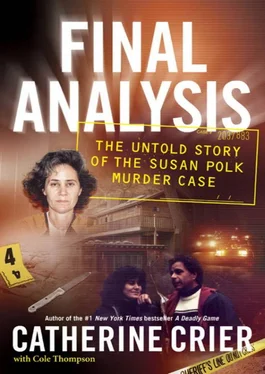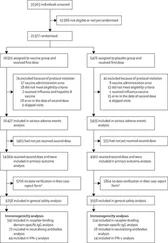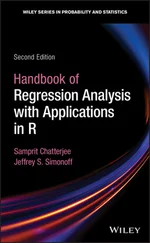The temporary home was cramped and without amenities. The couple had been pumping their water from a well on the property, where Dan intended to start a winery once construction was complete. It was no secret that Horowitz was wealthy, although it was unclear exactly how he had made his fortune.
Dan first met Pamela, a single mother of two, in 1994 when she moved to the Bay Area from Los Angeles County, according to a website maintained by Pamela’s family. At forty-one, she was a striking brunette, two years Dan’s senior and nearly three inches taller than the lawyer.
The couple was introduced by Pamela’s sister, who arranged for Pam, an independent film producer, to read a script that Dan had written about one of his cases. Bright, ambitious, and sophisticated, Pamela was employed full time as a software-marketing executive and was raising a sixteen-year-old daughter and nineteen-year-old son. Later, she would apply her computer savvy smarts to Dan’s law firm, maintaining databases and supervising the construction of their twelve-acre mountaintop estate.
Horowitz knew something was wrong the minute he spotted his wife’s car in the driveway. She was supposed to be going to the Kirov Ballet in Berkeley that night. His suspicions increased when he found the front door of the trailer unlocked. Stepping inside, he gasped at the sight of his wife lying on her right side in a pool of blood, her body pushed up against the couple’s sixty-five-inch television set. She was dressed in a T-shirt and panties, and there was a giant gash on her head. The carpet beneath her was red with blood, and the living room furniture had been moved about. The giant TV had been shoved nearly two and a half feet from its usual spot.
Hysterical, the lawyer called 911.
“Help me, she’s dead!” he yelled into the receiver and then knelt down beside his wife’s body. Cradling her in his arms, he tried to absorb the sight of her beaten and mutilated face.
“Who could have done this?” he raged.
The sound of a police car roaring up the driveway startled him to his feet. Racing outside, he shouted to the responding officers from the Lafayette Police Department. Almost immediately, they pushed him into the police car and ordered him to wait while a team from the Contra Costa Sheriff’s Department inspected the crime scene.
That night, sheriff’s officers took Horowitz to department headquarters, where he was escorted to a room normally used to interview child victims. Over several hours, investigators fired a series of questions at him, first trying to determine if he was suicidal. Next, they handed him a pen and paper and directed him to reconstruct his movements; they wanted a detailed accounting of his whereabouts that day.
Horowitz told officers he hadn’t heard from his wife all day. He left home early that morning, around 7:30 AM, to meet a friend for breakfast. Upon arriving at his Oakland law office around 9:30, he tried to reach Pamela on her cell phone. She didn’t answer. He met with a private investigator at 10:45 and finished up some work on the Polk case.
It was 2 PM when he dialed Pamela for a second time with no success. Though he found it strange that she was not answering her phone, he wasn’t alarmed. His wife was a former high-tech executive who had traveled extensively, both domestically and internationally. At 5′9″ and 178 pounds, she was no pushover. He assumed she was probably just busy with things at the house.
Horowitz told investigators that he left Oakland shortly thereafter. Later he made a deposit at the bank, and grabbed a Starbuck’s coffee in town before heading to the gym. After his workout, he headed for home, where he found his wife murdered.
Though short and slender, Horowitz had a wiry strength. While he stood barely 5′8″, with thinning brown hair and rimless eyeglasses perched atop a prominent nose, he had honed the physique of a person who worked out seriously at the gym. Like many defense lawyers, Horowitz had received his share of threats over the years. Staying in top physical shape gave him a sense of security. He informed police he was licensed to carry a gun.
An initial investigation by members of the Contra Costa crime lab determined that Pamela Vitale was savagely beaten with “multiple objects” during the attack that claimed her life. Evidence collected at the crime scene indicated that she was hit numerous times with several different weapons, although police declined to reveal further details of the brutal assault other than to say that Pamela’s death was “violent.”
A coroner’s report would later reveal that the fifty-two-year-old was found facedown on the carpet. She was struck more than two dozen times in the head, some of the blows so powerful they dislodged her front teeth and exposed sections of her skull. She had also been stabbed in the abdomen while she lay dead in a pool of blood.
News of the horrific killing quickly drew national media attention to Susan Polk, as speculation swirled that Vitale’s death might somehow be linked to the Polk case. It seemed an eerie coincidence that both Felix Polk and Pamela Vitale had been brutally stabbed, although initial media reports stated only that Vitale had been bludgeoned to death. It was not long after Pamela’s body was discovered that police began looking into the possibility the cases were linked.
Among those interviewed by investigators was Susan’s middle son, Eli Polk, his younger brother, Gabriel, and lawyer Barry Morris. Investigators also questioned a number of the construction workers employed by Horowitz, as well as a neighbor, Joseph William Lynch, who had recently sold the couple four acres in Hunsaker Canyon.
A subsequent investigation revealed that Vitale and her husband had filed a restraining order against Lynch in Contra Costa Superior Court in June 2005. In the complaint, they charged that Lynch was mentally ill and a methamphetamine and alcohol user who routinely harassed them and other neighbors in the Lafayette area. Police were surprised to learn that the couple later elected not to serve Lynch with the court order after hearing that he had signed up for a drug rehabilitation program and was trying to clean up his act.
Lynch denied any involvement in the murder, claiming that Pamela and Horowitz were good people who had supported his efforts to get sober. “Dan was trying to help me,” Lynch told the San Francisco Chronicle. “I have a drug problem, an alcohol problem, and a big mouth. I’m clean and sober now. Dan and Pamela were really trying to help me.”
There was also mention of a former boyfriend of Pamela’s who had been trying to get back together with her in recent months, but Horowitz expressed doubt about the man’s involvement in his wife’s death. “I just think he knows what he missed out on,” the lawyer told a reporter for a local newspaper. “But to think of him as a suspect would be a grave injustice.”
On Monday, October 17, Dan Horowitz was at home making funeral arrangements when Judge Laurel Brady, at the request of Susan’s other attorney, Ivan Golde, dismissed the Polk jury and declared a mistrial in the case. Brady cited extensive media coverage of Pamela Vitale’s murder as grounds for her decision.
“Ladies and gentlemen, it would be hard to miss, despite my admonitions,” the judge told jurors over the sobs of Susan Polk. “I have reached the conclusion at this juncture that it is not possible to continue the trial.”
Brady ordered all parties back to court on December 2 to set a new trial date, but no one—including Dan Horowitz—knew if he could put aside the turmoil in his own life and represent Susan. Horowitz acknowledged his own uncertainty in an interview with the local daily, the Contra Costa Times. “I don’t know,” he told the newspaper when asked about representing Susan Polk. “I don’t know if I’m alive. I don’t know if I’m in hell.”
Читать дальше











